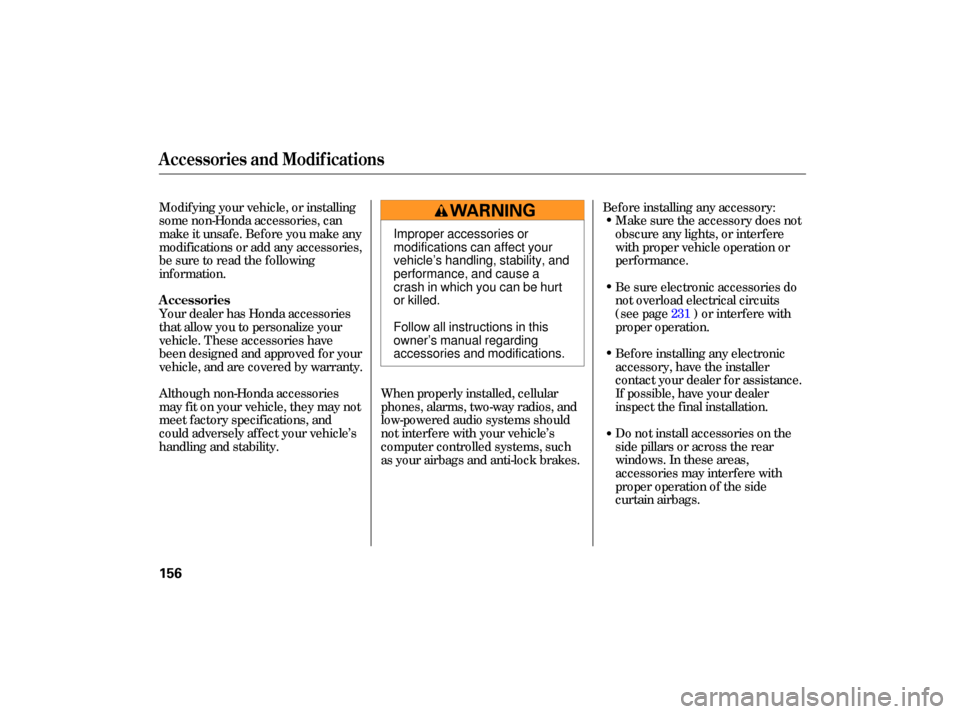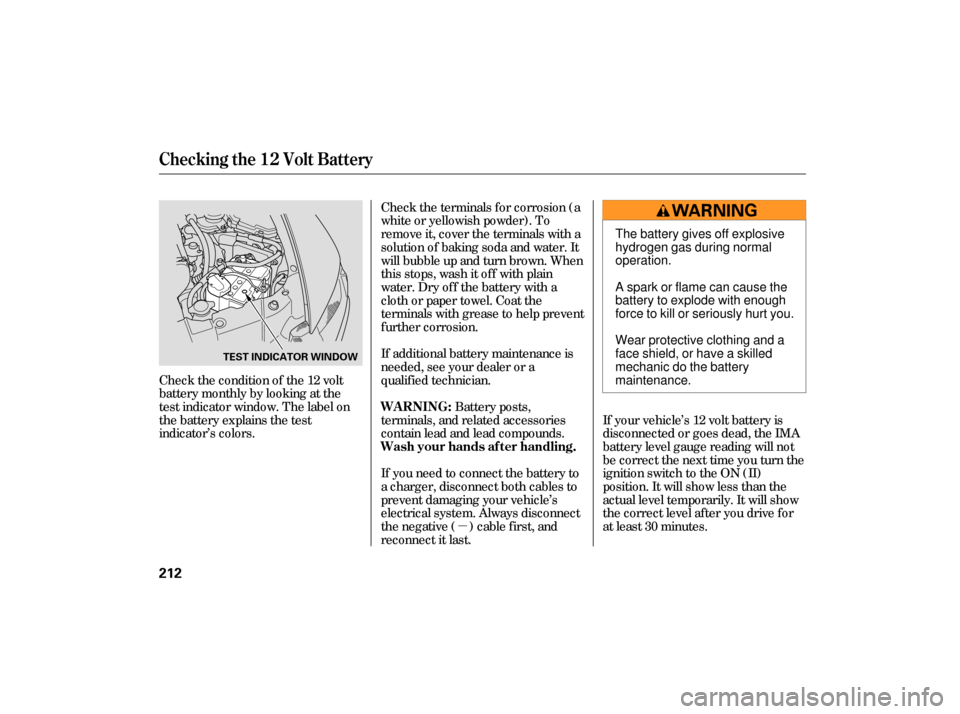Page 158 of 267

Your dealer has Honda accessories
that allow you to personalize your
vehicle. These accessories have
been designed and approved for your
vehicle, and are covered by warranty.
When properly installed, cellular
phones, alarms, two-way radios, and
low-powered audio systems should
not interfere with your vehicle’s
computer controlled systems, such
as your airbags and anti-lock brakes. Befo
re installing any accessory:
Make sure the accessory does not
obscure any lights, or interfere
with proper vehicle operation or
performance.
Be sure electronic accessories do
not overload electrical circuits
(see page ) or interf ere with
proper operation.
Modif ying your vehicle, or installing
some non-Honda accessories, can
make it unsaf e. Bef ore you make any
modif ications or add any accessories,
be sure to read the f ollowing
inf ormation.
Although non-Honda accessories
may f it on your vehicle, they may not
meet f actory specif ications, and
could adversely af f ect your vehicle’s
handling and stability.
Bef ore installing any electronic
accessory, have the installer
contact your dealer for assistance.
If possible, have your dealer
inspect the f inal installation.
Do not install accessories on the
side pillars or across the rear
windows. In these areas,
accessories may interf ere with
proper operation of the side
curtain airbags.231
A ccessories
A ccessories and Modif ications
156
Improper accessories or
modifications can affect your
vehicle’s handling, stability, and
performance, and cause a
crash in which you can be hurt
or killed.
Follow all instructions in this
owner’s manual regarding
accessories and modifications.
�����—�����—�����y�
����
��������y���
�(�#���������y���
�����y
Page 166 of 267
Make sure all windows, mirrors,
and outside lights are clean and
unobstructed. Remove frost, snow,
or ice.Check that any items you may be
carrying are stored properly or
fastened down securely.
Check the seat adjustment (see
page ).
Check the adjustment of the
inside and outside mirrors (see
page ).
Check the steering wheel
adjustment (see page ).
Make sure the doors are securely
closed and locked.Fasten your seat be
lt. Check that
your passengers have fastened
their seat belts (see page ).
Youshoulddothefollowingchecks
and
adjustmen ts before you drive
your vehicle.
When you start the engine, check
the gauges and indicato rs in the
instrument panel (see page ).
Check that the hood and trunk are
fully closed.
Visually check the tires. If a tire
looks low, use a gauge to check its
pressure (see page ).
1.
2.
3.
8. 7. 6. 14
9.
4.
5.
207 93
75
89
57
10.
Preparing to Drive
164
�����—�����—�����y�
����
��������y���
�(�#���������y���
�����y
Page 172 of 267

�µ
�µ
To maximize f uel economy, your
Civic Hybrid has an Auto Idle Stop
f unction. Under certain conditions,
the engine will shut of f when you
come to a stop. Those conditions are:
The engine coolant is nearly up to
normal operating temperature.
The shift lever is in D or N.
You are not pressing on the
accelerator pedal.
The IMA battery is charged
enough to operate the system. You are pressing on the brake
pedal.
Fan speed lower f an speeds, in
either AUTO or manual modes. The f ront window def roster is of f .
Outside temperature is between
10 100 degrees F. The Auto Idle Stop f unction activates
if you speed up to 8 mph (12 km/h)
over and brake to a stop. And it can
activate twice even if you speed up to
8 mph (12 km/h) or below and brake
to a stop.
The engine will start again when you
release the brake pedal. It will also
restart, even if you are still pressing
the brake pedal, under these
conditions:
You move the shif t lever f rom D
or N to R or L.
You press the accelerator pedal.
You are on an incline, and the
vehicle begins rolling. The Auto Idle Stop f unction may
activate when you slow down.
Auto Idle Stop
Automatic Transmission (CVT)
170
�����—�����—�����y�
����
��������y���
�(�#���������y���
�����y
Page 174 of 267

Always use the parking brake when
you park your vehicle. Make sure
the parking brake is set f irmly, or
your vehicle may roll if it is parked
on an incline.
If your vehicle has an automatic
transmission, set the parking brake
bef ore you put the transmission in
Park. This keeps the vehicle f rom
moving and putting pressure on the
parking mechanism in the
transmission.Make sure the windows are closed.
Turn of f the lights.
Place any packages, valuables, etc.,
in the trunk or take them with you.
Lockthedoorswiththekeyorthe
remote transmitter.
Check the indicator on the
instrument panel to verif y that the
security system is set.
Never park over dry leaves, tall
grass, or other f lammable
materials. The hot three way
catalytic converter could cause
these materials to catch on fire.
If the vehicle is f acing uphill, turn
the front wheels away from the
curb.If the vehicle is f acing downhill,
turn the front wheels toward the
curb.
Make sure the parking brake is
f ully released bef ore driving away.
Driving with the parking brake
partially set can overheat or
damage the rear brakes.
Parking T ips
Parking
172
Never install a sunshade between the
upper and lower meters on the
instrument panel. If you do, you could
cause heat damage to the upper meter
on a very hot day.
�����—�����—�����y�
����
��������y���
�(�#���������y���
�����y
Page 214 of 267

�µ
Check the condition of the 12 volt
battery monthly by looking at the
test indicator window. The label on
the battery explains the test
indicator’s colors.
If your vehicle’s 12 volt battery is
disconnected or goes dead, the IMA
battery level gauge reading will not
be correct the next time you turn the
ignition switch to the ON (II)
position. It will show less than the
actual level temporarily. It will show
the correct level af ter you drive f or
at least 30 minutes.
Check the terminals f or corrosion (a
white or yellowish powder). To
remove it, cover the terminals with a
solution of baking soda and water. It
will bubble up and turn brown. When
this stops, wash it of f with plain
water. Dry off the battery with a
cloth or paper towel. Coat the
terminals with grease to help prevent
f urther corrosion.
If additional battery maintenance is
needed, see your dealer or a
qualif ied technician.
Battery posts,
terminals, and related accessories
contain lead and lead compounds.
If you need to connect the battery to
a charger, disconnect both cables to
prevent damaging your vehicle’s
electrical system. Always disconnect
the negative ( ) cable first, and
reconnect it last.
Checking the 12 Volt Battery
WARNING:
Wash your hands af ter handling.
212
TEST INDICATOR WINDOW
The battery gives off explosive
hydrogen gas during normal
operation.
A spark or flame can cause the
battery to explode with enough
force to kill or seriously hurt you.
Wear protective clothing and a
face shield, or have a skilled
mechanic do the battery
maintenance.
�����—�����—�����y�
�������������y���
�(�#���������y�����
���y
Page 215 of 267

Fill the f uel tank.
Change the engine oil and f ilter.Block the rear wheels.
If the vehicle is to be stored f or a
longer period, it should be
supported on jackstands so the
tires are of f the ground.
Wash and dry the exterior
completely.
Cleantheinterior.Makesurethe
carpeting, floor mats, etc., are
completely dry.
If you need to park your vehicle f or
an extended period (more than 1
month), there are several things you
should do to prepare it f or storage.
Proper preparation helps prevent
deterioration and makes it easier to
get your vehicle back on the road. If
possible, store your vehicle indoors. Leave one window open slightly (if
the vehicle is being stored
indoors).Cover the vehicle with a
‘‘breathable’’ cover, one made
f rom a porous material such as
cotton. Non-porous materials, such
as plastic sheeting, trap moisture,
which can damage the paint.
To minimize sticking, apply a
silicone spray lubricant to all door
and trunk seals. Also, apply a
vehiclebodywaxtothepainted
surfaces that mate with the door
and trunk seals. Support the f ront wiper blade
arms with a f olded towel or rag so
they do not touch the windshield. Disconnect the 12 volt battery. Reconnect the 12 volt battery and
drive your vehicle every month f or
about 30 minutes. This will keep
the IMA battery charged and in
good condition.
Leave the parking brake off. Put
the transmission in Park. If possible, periodically run the
engine until it reaches f ull
operating temperature (the
cooling f an cycles twice).
Pref erably, do this once a month.
Vehicle Storage
Maint enance
213
�����—�����—�����y�
���������
���y���
�(�#���������y�����
���y
Page 230 of 267

�µ
�µ
If theAutoIdleStopisactiveforan
extended period, the charging
system indicator may come on. If it
happens, start the engine.
The charging system indicator may
also come on if the Integrated Motor
Assist (IMA) battery charge drops
below a desired level and the engine
starts to recharge the battery.
This indicator may blink af ter you
start the vehicle in the morning
when the temperature is below 20
°F ( 30°C). It will stop blinking
when the IMA battery warms up.
If the charging system
indicator comes on brightly
when the engine is running,
the 12 volt battery is not being
charged.
Immediately turn of f all electrical
accessories. Try not to use other
electrically operated controls such as
the power windows and rear window
def ogger. Keep the engine running;
starting the engine will discharge the
battery rapidly.
Go to a service station or garage
where you can get technical
assistance.
Charging System Indicator
228
�����—�����—�����y�
�������������y���
�(�#���������y�������
�y
Page 237 of 267
�µ
�µ
�Î
�Î
No.
Circuits Protected
Amps.
No. Amps. Circuits Protected
No. Amps. Circuits Protected
:
1
2
3
Main Fuse
EPS
Option Main
Ignition Switch Main
ABS
ABS
100 A
70 A
80 A
50 A
30 A
30 A
1
2
3
10 A
7.5 A 15 A IMA2
IMA1
Booster MS
4
5
6
7
8
9
10
11
12
13
14
15
16
17
18
19
20
21
22
23 50 A
40 A
40 A
20 A
20 A
30 A
40 A
10 A
15 A
15 A
15 A
15 A
7.5 A
20 A
15 A
7.5 A 15 A
7.5 A 10 A Headlight Main
Power Window Main
Booster Motor
Sub Fan Motor
Main Fan Motor (A/T)
Rear Defogger
Blower
Hazard
FI Sub
Stop and Horn
IG Coil (EX)
IG Coil (IN)
Oil Level
Not Used
Not Used
IG Coil
FI Main
MG Clutch
DBW
Interior Light
Back Up
If equipped
Fuse Locations
T aking Care of t he Unexpect ed
235
UNDER-HOOD PRIMARY FUSE BOX UNDER-HOOD SECONDARY FUSE BOX
�����—�����—�����y�
�����������
�y���
�(�#���������y���������y